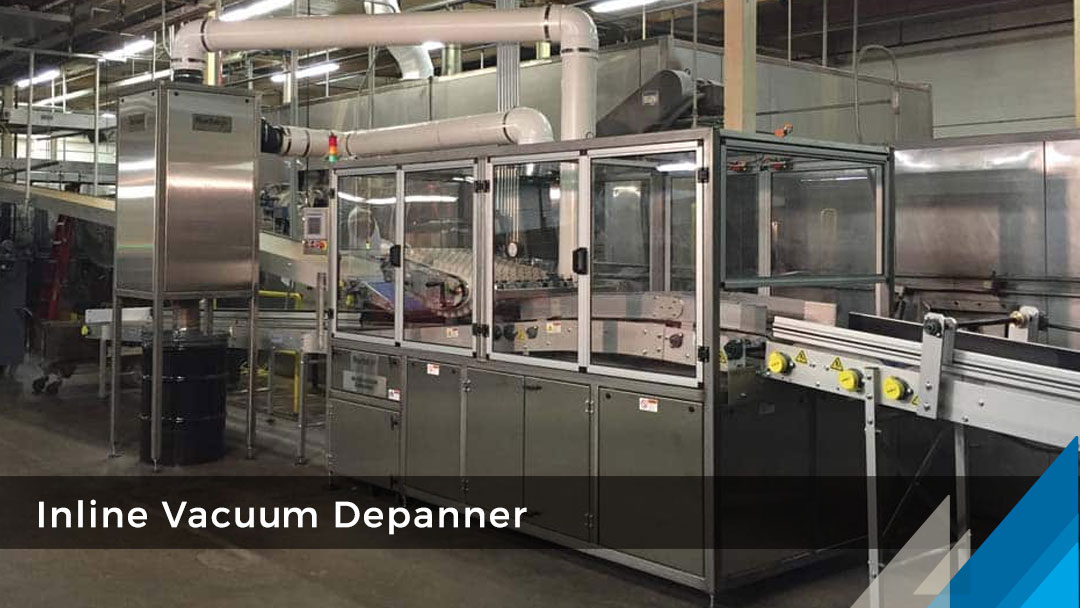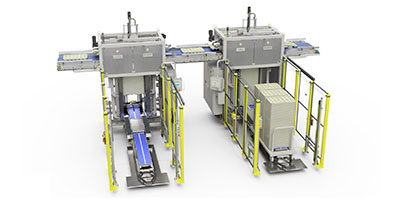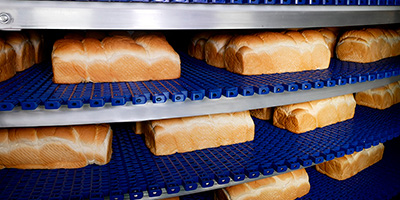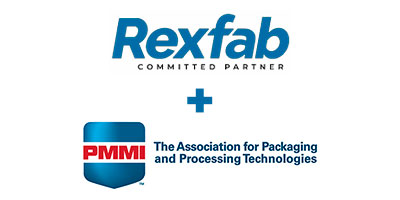
QUICK MENU
1.- Introduction
4.- Case Study: Inline Vacuum Depanner
5.- Conclusion
Introduction
Safety within the industrial bakery realm is not just a regulatory requirement; it’s a cornerstone for operational excellence and profitability. The industry, known for its rigorous pace and heavy machinery, presents unique challenges. Adhering to safety standards is not merely about compliance—it’s about enhancing productivity, quality, and ultimately, the bottom line.
Let’s begin by shedding some light on how safety can elevate productivity. Putting extra time and resources into upholding and keeping safety standards may seem counterproductive. However, a safe workplace fosters a sense of trust and security among employees, leading to enhanced morale and engagement. They not only show increased commitment to their tasks but also take additional care in their duties, reducing error rates.
Quality and Safety: A Symbiotic Bond
A quality product is synonymous with the safety protocols driving its creation. Adequate safety measures ensure that all technical processes are executed correctly, keeping the quality of the final product. The lessening of mishaps, whether due to mishandling of machinery or miscommunication, also prevents inferior quality products from hitting the shelves. This substantial boost in quality often directly leads to improved customer satisfaction and brand reputation.
Workplace Safety: A Profit Booster
Reduced incidents in the workplace equate to higher profitability in multiple ways. Fewer accidents mean lesser costs for replacement staff, medical bills, compensation, and damages to equipment. It also reduces time lost in production stoppages. Employers may also enjoy lower insurance premiums due to lesser accident claims. Thus, gravity should be given to make safety a priority in these environments.
Remember, safety should never be seen as a significant financial burden and unnecessary formality. It’s a company’s moral duty and, more importantly, a profoundly profitable business strategy.
Considering all the benefits mentioned above, its clear industrial bakery companies have a lot to gain from insisting on stringent safety measures. Investing in safety isn’t an expense—it’s a strategic, long-term investment that can yield significant dividends.
Making Safety a Core Aspect of Business
To truly embrace safety in the workplace, it should become a core part of the company culture. It’s not enough to have the right safeguards in place; employees must understand their importance and strictly adhere to them. Continuing education programs on safety protocols is key in this aspect. Furthermore, managers and supervisors should lead by example and reinforce the safety-first approach on a day-to-day basis.
By giving safety the priority, it deserves, your company will not only meet regulatory standards but also cultivate an environment where employees can work efficiently and confidently. As we’ve already established, this leads to improved quality, productivity, and profitability—making safety a win-win situation for everyone involved.
The Cost of Complacency
Statistics from the Health and Safety Executive (HSE) highlight a startling reality: bakers and flour confectioners face an injury incidence rate 18.2 times higher than the average workplace. These aren’t just numbers; they represent real risks that can translate into significant financial losses due to downtime, litigation, and damaged reputations.
Consider the next facts found on industry articles:
Every 7 seconds, a worker is injured on the job.
Workplace accidents result in 104 million lost production days per year.
Workplace injuries cost businesses $170.8 billion annually in the United States.
Implementing safety measures can save businesses $4 to $6 for every $1 invested.
Investing in safety brings great returns – fewer injuries, illnesses, and fatalities; better morale; lower workers’ compensation costs; and higher productivity.
– Thomas J. Sargent
Breaking Down the Numbers
Don’t let numbers scare you; they’re actually your best ally when talking about workplace safety. They speak louder than words by quantifying the immense benefit of safety measures.
Let’s read into these concrete savings you can make. Throughout your business, by meeting or exceeding safety standards, you invest in not only the morale and health of your employees but also the vitality of your business. These savings can come in the form of decreased workers’ compensation costs, a reduction in lost work hours due to injuries and increased productivity and employee morale.
Sketching the Big Picture
Sometimes, we can overlook the bigger picture in the quest for immediate gains or reducing overheads. However, a complete disregard for safety protocols can lead to catastrophic results, both human and financial.
Is it worth the risk? An incident-free workplace not only saves money but also enhances your reputation as a responsible employer that values its workforce. Such stature attracts talented individuals and positively contributes to your bottom line in the long run.
A People-Centric Approach
The crux of safety at work is about people: your employees. They are your most significant asset, and their safety directly affects your success.
By designing a work environment with employee safety in mind, you’re creating a platform where everyone feels secure and valued. When employees can work without fear for their safety, productivity increases, teams collaborate more effectively, and your company thrives. So, it’s clear that investing in safety isn’t just the right thing—it’s also a smart, profitable business move.
The Hazard Landscape
Bakeries, as dynamic environments, are rife with potential hazards. Flour dust, for example, can lead to respiratory issues and skin sensitization. The Occupational Safety and Health Administration (OSHA) identifies several threats specific to bakeries, such as slips and trips, work equipment mishaps, and fire risks. For commercial bakeries, the recordable injury rate stands at 5.4 per 100 employees – a figure that underscores the need for vigilance.
Process Optimization: Enhancing Efficiency and Safety
In the often fast-paced, deadline-oriented work environment, there tends to exist a misguided belief that safety measures slow down processes. However, companies must come to grasp with a crucial understanding: safety and efficiency are not mutually exclusive; in fact, they are closely intertwined.
Optimizing business processes involves refining procedures, reducing waste, and using technology to increase productivity and safety. It is not about cutting corners or neglecting safety protocols to save time or stretch the bottom line. The true mark of successful process optimization lies in striking the perfect balance between efficiency and workplace safety.
Realizing Efficiency Through Safe Practices
A workplace designed with safety in mind is typically more organized, streamlined, and efficient. This can be achieved through several means, some of which are:
- Use of safety equipment and protective gear enhances employees’ ability to perform tasks without fear of accidents or injuries.
- Providing adequate training and safety education equips employees with the knowledge and skills to perform tasks properly and safely, reducing the risk of accidents due to human error.
- Cultivating a safety-conscious culture encourages employees to prioritize safety, leading to meticulous execution of tasks, attention to detail, and an overall increase in efficiency.
Technological Advancements: A Valid Solution
Today’s modern workplace leverages technology not just for greater productivity, but also for improved safety. Sophisticated health and safety management systems are now being used to monitor and control hazards and thus mitigate the risk of workplace accidents and illnesses. These digital solutions enable real-time reporting and analysis of safety metrics, easing proactive incident prevention and fostering a culture of safety.
For example, advancements in automation technologies have outsourced many high-risk tasks to machines, significantly reducing the potential for human error that can lead to accidents. Thus, a tech-savvy approach to safety management can produce significant benefits, both in terms of safeguarding employees and enhancing process efficiency.
The Bottom Line: Prioritize Safety
In conclusion, businesses that prioritize safety as a core part of their operating strategies often realize increased productivity, improved morale, and reduced potential for penalties from safety violations. In this light, focusing on safety is not just a moral duty — it is indeed a smart business strategy.
Production Line Technological Upgrades: Advancing Safety Measures
Technological advancements are revolutionizing production lines, enhancing not only efficiency but also safety. By integrating proactive measures and sophisticated technologies, industry leaders like Rexfab are significantly mitigating workplace hazards.
A critical aspect of this shift is the advent of advanced conveyor systems. Rexfab’s automated conveyors reduce the necessity of manual material handling, significantly lowering the risk of physical injuries. Their precise, predictable movements also mitigate the possibility of unwanted mishaps from human error.
Applying advanced sanitation technologies is fundamental to promoting safety in food or industrial bakery settings. Rexfab employs innovative cleanliness practices to secure an uncontaminated production environment. This effectively reduces the probability of incidents related to food contamination, so fostering a safer and more efficient baking operation.
The automation of analog processes is another revolutionary step taken by Rexfab. The company’s seamless integration of digital systems into traditional production methods leads to reduced human intervention, addressing the risk of human-induced errors, and thereby offering a more secure working environment.
Furthermore, the burgeoning use of the Industrial Internet of Things (IIoT) is a game-changing factor. Rexfab’s use of sensors and smart devices connected through IIoT enable real-time monitoring, predictive maintenance, and instant alert systems, promoting proactive safety management.
- Automated conveyors lower the need for manual handling, reducing accidents resulted from human error.
- High-grade sanitization measures ensure a safer environment.
- Automation of analog processes greatly minimizes the chance of human-induced errors.
- IIoT promotes real-time safety surveillance and immediate incident reporting.
In conclusion, companies like Rexfab leverage technological advancements to boost workplace safety. By integrating these technologies into their production lines, safety is not only reinforced but productivity and profitability are also amplified.
Case Study: Inline Vacuum Depanner
A prime example of safety-oriented design in bakery equipment is Rexfab’s Inline Vacuum Depanner (IVD). Its user-friendly interface prevents operators from making manual adjustments that could lead to errors.
The IVD’s sanitary design not only streamlines the cleaning process but also minimizes the risk of food recalls, protecting both consumer health and the bakery’s brand.
In the competitive landscape of industrial bakeries, operational efficiency, and product integrity are paramount.

The Inline Vacuum Depanner (IVD) by Rexfab stands for a harmonious blend of these attributes, particularly emphasizing workplace safety. Let’s delve deeper into the IVD’s innovative design and how it serves as a benchmark for safety and efficiency in the bakery industry.
Enhanced Operator Safety and Efficiency
The IVD boasts a fully menu-driven Human Machine Interface (HMI), which is a significant step forward in operator safety. This design choice prioritizes the elimination of manual intervention, which is often the root cause of operational mishaps. By preventing the need for numerous manual adjustments, the IVD reduces the risk of human error, which is a common source of workplace injuries and inefficiencies. This feature ensures that once an operator selects the proper recipe, the machine keeps the settings, supplying consistent and safe operation without further manual input.
Sanitary Design for Food Safety
Rexfab has ingeniously designed the IVD with sanitation as a forefront consideration. The construction of the machine features stainless steel and maximized angled surfaces, which are less conducive to buildup and contamination. This meticulous design significantly reduces the time needed for cleaning, which not only increases the available production time but also substantially decreases the likelihood of product contamination that can lead to costly food recalls. In an era where consumer health is under the microscope and brand reputation can be marred by a single incident, the IVD’s sanitary design offers a robust defense against such threats.
Integration and Customization
The IVD’s adaptability is another testament to its safety-oriented design. It can be seamlessly integrated into existing production lines as a stand-alone unit, making it a versatile solution for bakeries looking to replace less efficient and potentially more hazardous equipment. This ease of integration is complemented by customization options, such as the infeed metering conveyor and remote cyclone separator for specific topping types, which further automates and optimizes the depanning process.
Operational Soundness and Sustainability
Furthermore, the IVD operates below 85 decibels, minimizing ambient noise levels that can be a health hazard in industrial settings. This reduction in noise pollution contributes to a safer and more comfortable working environment, which can also improve focus and reduce the risk of accidents.
Conclusion
Safety in the industrial bakery sector is a complex but rewarding investment. It requires a multifaceted approach that includes employee training, equipment that prioritizes operator and product safety, and a culture that sees beyond compliance to the value of well-being. In this light, safety is indeed the right—and profitable—thing to do.
Rexfab’s IVD exemplifies the intersection of innovation, safety, and operational excellence. By incorporating features that prioritize user safety, product integrity, and seamless integration, the IVD stands out as not just a piece of equipment but as a comprehensive solution contributing to the higher safety standards and efficiency that modern industrial bakeries strive for.
Investing in safe practices and equipment like the IVD is not just about avoiding costs; it’s about enhancing efficiency. With features like stainless steel construction for exceptional sanitation and noise level minimization, the IVD exemplifies how safety contributes to a quieter, cleaner, and more safe and efficient production line.
FAQs
1. How does workplace safety impact productivity in industrial bakeries?
A: A safe work environment boosts employee morale, which leads to increased commitment, reduced error rates, and higher overall productivity.
2. Can investing in safety measures actually save money for industrial bakeries?
A: Yes, it’s estimated that businesses can save $4 to $6 for every dollar invested in safety measures by reducing costs associated with workplace injuries.
3. What are some common hazards in bakery environments?
A: Hazards include flour dust leading to respiratory issues, slips and trips, work equipment mishaps, and fire risks.
4. How does the Inline Vacuum Depanner (IVD) by Rexfab enhance safety?
A: The IVD features a fully menu-driven HMI to eliminate manual errors, a sanitary design that reduces cleaning time and contamination risk, and seamless integration into existing lines, all contributing to a safer workplace.
5. Why is a safety-first culture important in the industrial bakery setting?
A: A safety-first culture ensures that employees understand the importance of safety protocols, leading to a safer, more efficient, and more profitable operation.
References & resources
- Health and Safety Executive (HSE) statistics on workplace injuries.
- Occupational Safety and Health Administration (OSHA) guidelines for bakery safety.
- Case studies on the financial impact of safety investments, such as the one by Thomas J. Sargent.
- Technological advancements in safety equipment and management systems.
Safety by Design: How Rexfab’s Engineering Philosophy Drives Operational Excellence
In the fast-paced world of industrial baking and food processing, safety isn’t just a compliance requirement – it’s a cornerstone of long-term operational success. At Rexfab, we believe that designing and constructing equipment and conveyor systems with safety at the forefront not only protects people but also significantly boosts productivity while reducing overall operational costs.
Rexfab & Intralox: A Game-Changer for the Baking Industry
Rexfab, an expert in automation solutions for the baking industry, and Intralox, a global leader in innovative conveyor belt solutions, joined forces and have been working together to revolutionize production efficiency and product quality in the baking industry.
Strengthening Ties with PMMI: A Distinguished Visit to Rexfab
On August 22nd, Rexfab was honored to host Andrew Dougherty, VP of Member Services at PMMI. The visit allowed us to showcase our innovative solutions and learn more about PMMI’s vision for the future.





